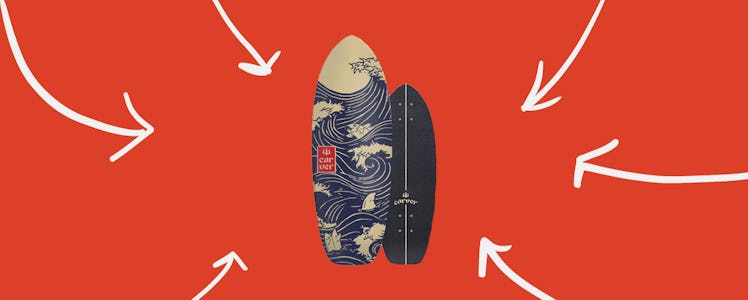The Carver Snapper Is the Kids Skateboard You Wish You’d Had
A Carver board got me back into skating and, far more importantly, turned my kid into an addict, saving me from the soccer sidelines.

In high school and for the first few years of college, skateboarding was both my life and my drug of choice. I was nowhere as good as my punk rock friends, who fearlessly aired over the coping on Athens, Georgia’s Wildebeest halfpipe, but I was competent enough — capable of ollies, railslides, and vert-ramp fundamentals — to hang (and break a couple of bones). Halfway through my junior year, I was seduced by mountain bikes and singletrack. A stint at Surfer magazine further diverted my attention. My battered G&S deck became decor.
Then, four years ago, I watched a mom friend I knew from surfing cruise our Charleston elementary school basketball court on a fat-wheeled, fat-decked, 80’s-era-looking skateboard. But as Tara made zippy circles around the concrete, something didn’t compute. She wasn’t pushing, just turning sharply from side to side with both feet planted on the board. Her hips moved as if surfing an invisible wave. I was baffled—and intrigued.
“What the heck is that?” I asked her. “Does it have a motor?” No, she said, holding the board up. The rear truck looked normal enough, but the front had an added swing-arm pivot that enabled wicked tight turns. Tara called it a Carver. Seems it was invented 20 years ago by a couple of mad scientist surfers from Venice Beach. When Tara offered me a go, magic happened. Propelling the board’s grippy wheels through well-timed leg compressions felt almost exactly like surfing. Indeed, that’s why this growing genre of boards is called a surfskate. Her Carver was the opposite of the twitchy, rock-wheeled, twin-tipped trick boards you see under the feet of most skaters today. With a Carver, it’s all about turn and flow. In a few minutes, twenty-plus years of skating cobwebs were swept away and I was generating ridiculous speed. Screw batteries and a motor — pumping turns was a hell of a workout. I even managed a powerslide.
That Carver proved a gateway drug. I bought an identical Swallow model at the local surf shop. When my neighbor dads here in Charleston — they all surf too — saw me riding the thing, they bought boards and got hooked as well. When my son, who was six at the time, tried it out, I couldn’t get him off it. We all enjoyed the Carver set up for the same reason: It’s a surfboard for concrete. The fat wheels make the board fast, smooth and forgiving on bumpy concrete while the radical trucks allow the board to turn twice as sharply as a regular skateboard. At the same time, the swingarm design of Carver’s C7 truck makes it super resistant to speed wobbles even when hauling ass. In short. it’s easy to ride, but you can also rip the snot out of it. These factors are especially important for a small, lightweight kid, a beginner, or a dad getting back on board after a couple of decades. Fritz and I soon also came into a second Carver — a sporty little model called a Snapper. Instead of the high-tech swing-arm C7 model truck, the Snapper was equipped with an equally high-tech but more traditional looking truck called a CX. It still pumps, but is engineered for street-style skating.
Fast forward four years. My son has migrated to a traditional twin-tipped trick board to blast airs at Charleston’s most excellent local park, but he still shreds on the Swallow regularly on the concrete at home. I’ve modified a slightly longer Carver Point Break for climbing vertical skatepark walls by taking off the truck risers and putting on a set of old-school Speedlab Strange House wheels. The Speedlabs are much harder and smaller than the big gumballs the board came with, but are still just soft enough to allow pumping without uncontrolled slideouts. Nothing turns tighter or faster in the park’s tight corner pockets. I’m seeing more and more of them as Charleston’s surfers migrate to concrete.
Carvers are expensive, but you’re buying 21+years of American-built engineering and high-quality hardwood (I’m embarrassed to say my son’s has survived few evenings left out in the rain). You’re also buying access to a profoundly disorganized sport, a fun-for-everyone antidote to all those Saturday soccer games. If you’re really smart, you’ll buy two — along with a reissue of the debut album by Venice thrash gods Suicidal Tendencies. Over a Pepsi, you can show your kid how cool you once thought you were — and then go skate.
This article was originally published on